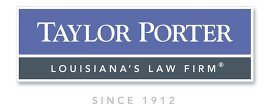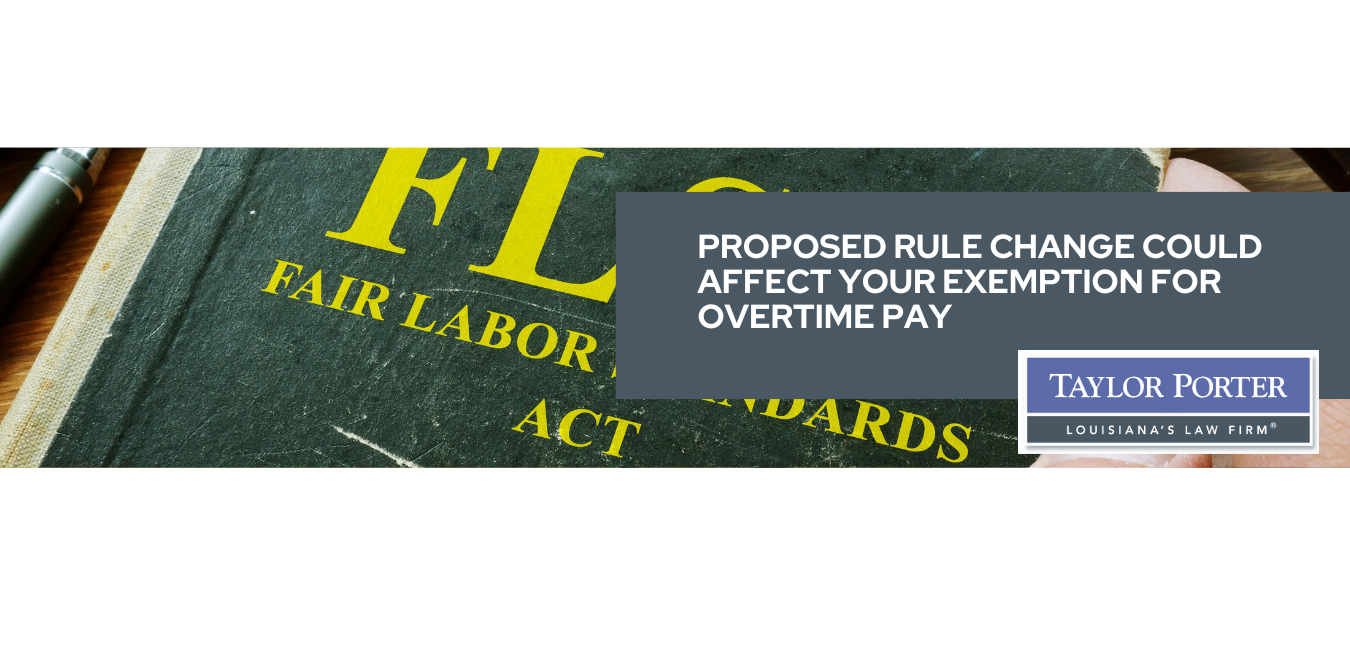DOL Issues Updated Guidance on Families First Coronavirus Response Act
By Taylor Porter Employment, Labor & Benefits Practice Group
On Wednesday, April 1, 2020, the Wage and Hour Division (WHD) of the United States Department of Labor (DOL) issued additional Emergency Paid Sick Leave and Expanded Family and Medical Leave guidance. This includes an Executive Summary and a temporary rule issuing regulations (https://www.dol.gov/sites/dolgov/files/WHD/Pandemic/FFCRA.pdf). There are a total of 24 regulations which contain detailed information regarding the FFCRA.
This update discusses select regulations and is not an exhaustive description. For a complete list of the regulations, as well as the Executive Summary, please see the Department of Labor, WHD website, a link to which is included in this update. Highlights include:
- Definition of “childcare provider” and “place of care” (Section 826.10)
- The FFCRA allows employees to take leave if a son or daughter’s “place of care” has been closed, or a “childcare provider” is unavailable. “Childcare provider” is defined as a provider who received compensation for providing child care services on a regular basis. It also, however, includes an individual who is not compensated or licensed if he or she is a family member or friend who regularly cares for the employee’s child. “Place of care” is the physical location at which the care is provided. This location need not be solely dedicated to childcare and can include preschools, after school care programs, summer camps, respite care programs and homes.
- The FFCRA allows employees to take leave if a son or daughter’s “place of care” has been closed, or a “childcare provider” is unavailable. “Childcare provider” is defined as a provider who received compensation for providing child care services on a regular basis. It also, however, includes an individual who is not compensated or licensed if he or she is a family member or friend who regularly cares for the employee’s child. “Place of care” is the physical location at which the care is provided. This location need not be solely dedicated to childcare and can include preschools, after school care programs, summer camps, respite care programs and homes.
- Definition of “son or daughter” (Section 826.10)
- These terms have the same meaning as they are given in the FMLA (29 USC 2611). Son or daughter means biological, adopted, or foster child, stepchild, legal ward, or the child under 18 years of age of a person standing in loco parentis. Additionally, a child who is 18 years or older and incapable of self-care because of a mental or physical disability also meets the definition.
- These terms have the same meaning as they are given in the FMLA (29 USC 2611). Son or daughter means biological, adopted, or foster child, stepchild, legal ward, or the child under 18 years of age of a person standing in loco parentis. Additionally, a child who is 18 years or older and incapable of self-care because of a mental or physical disability also meets the definition.
- Caring for an Individual who has been Quarantined (Section 826.20)
- “Individual” is defined to mean an employee’s immediate family member, a person who regularly resides in the employee’s home or a similar person with whom the employee has a relationship that creates an expectation that the employee will care for the person. “Individual” does not include persons with whom the employee has no personal relationship.
- “Individual” is defined to mean an employee’s immediate family member, a person who regularly resides in the employee’s home or a similar person with whom the employee has a relationship that creates an expectation that the employee will care for the person. “Individual” does not include persons with whom the employee has no personal relationship.
- Caring for a Son or Daughter (Section 826.20)
- Under both the Emergency Paid Sick Leave Act and the Emergency Family and Medical Leave Expansion Act, an employee is eligible for leave if caring for a son or daughter. An employee qualifies for this leave “only if no other suitable person is available to care for the son or daughter during the period of such leave.”
- Under both the Emergency Paid Sick Leave Act and the Emergency Family and Medical Leave Expansion Act, an employee is eligible for leave if caring for a son or daughter. An employee qualifies for this leave “only if no other suitable person is available to care for the son or daughter during the period of such leave.”
- Employment for at least 30 Calendar Days (Section 826.30)
- The regulations provide additional guidance for determining employment for thirty (30) days for the purposes of Expanded Family and Medical Leave. The regulations reiterate that the employee meets this criteria if he has been on the payroll for thirty (30) calendar days immediately prior to the need for leave or had been employed by a temporary agency and was subsequently hired by the employer so that the combined period was for thirty (30) calendar days immediately prior to the need for leave. The regulations also state that an employee who was laid off or terminated on or after March 1, 2020 and rehired before December 31, 2020 would qualify provided the employee was on the payroll for thirty (30) or more of the sixty (60) calendar days prior to the date the employee was laid off or terminated.
- The regulations provide additional guidance for determining employment for thirty (30) days for the purposes of Expanded Family and Medical Leave. The regulations reiterate that the employee meets this criteria if he has been on the payroll for thirty (30) calendar days immediately prior to the need for leave or had been employed by a temporary agency and was subsequently hired by the employer so that the combined period was for thirty (30) calendar days immediately prior to the need for leave. The regulations also state that an employee who was laid off or terminated on or after March 1, 2020 and rehired before December 31, 2020 would qualify provided the employee was on the payroll for thirty (30) or more of the sixty (60) calendar days prior to the date the employee was laid off or terminated.
- Notice to Employees (§ 826.80)
- Every employer should post and keep posted in a conspicuous place on its premises the DOL model notice (or equivalent) of employee rights (www.dol.gov/whd). It can also email the notice and post on its website.
- Every employer should post and keep posted in a conspicuous place on its premises the DOL model notice (or equivalent) of employee rights (www.dol.gov/whd). It can also email the notice and post on its website.
- Employee Notice of Need for Leave (§ 826.90)
- An employer can require its employees to provide notice of the basis for leave as soon as practicable after the first workday missed. An employer may not require advance notice of the need for leave. The employee’s notice may be verbal. Absent unusual circumstances, if an employee fails to give proper notice, the employee should be given an opportunity to provide the required documentation before denying the request for leave.
- An employer can require its employees to provide notice of the basis for leave as soon as practicable after the first workday missed. An employer may not require advance notice of the need for leave. The employee’s notice may be verbal. Absent unusual circumstances, if an employee fails to give proper notice, the employee should be given an opportunity to provide the required documentation before denying the request for leave.
- Documenting Need for Leave (§ 826.100)
- The employee must provide a written or verbal statement including the employee’s name, the date(s) for which leave is requested, the COVID-19 qualifying reason for leave, and a statement that the employee is unable to work or telework because of such reason.
- Additionally, depending on the stated reason for leave, the employee also must identify the government entity issuing a quarantine or isolation order applicable to the specific employee; the healthcare provider who advised him or her to self-quarantine for a COVID-19 related reason; and, the child being cared for, the school, place of care or childcare provider that is closed or unavailable because of COVID-19 as well as a statement that no other suitable person is available to provide care.
- If leave is requested because of an employee’s own serious health condition related to COVID-19 (or to care for the employee’s spouse, son, daughter, or parent with a serious condition related to COVID-19), the employee must furnish the name of his healthcare provider and other information the employer may request to support FFCRA tax credits.
- An employer is not required to provide leave if the employee fails to provide documentation sufficient to support the tax credits.
- Employers not otherwise subject to the FMLA (50 or more employees) do not have to respond to requests for leave with notices of eligibility, designations, that the requested leave qualifies as FMLA leave, etc.
- Continued Health Care Coverage (§ 826.110)
- An employee on leave is entitled to continued coverage under the employer’s group health plan as if the employee did not take leave. Employees remain responsible for paying the same portion of the plan premium and in the same manner as they did prior to taking leave. The employee may elect not to continue coverage during leave, but is entitled to have the coverage reinstated after leave.
- An employee on leave is entitled to continued coverage under the employer’s group health plan as if the employee did not take leave. Employees remain responsible for paying the same portion of the plan premium and in the same manner as they did prior to taking leave. The employee may elect not to continue coverage during leave, but is entitled to have the coverage reinstated after leave.
- Right to Reinstatement of Employment (§ 826.130)
- In most cases, an employee is entitled to reinstatement to the same or an equivalent position after leave. However, reinstatement is not required if the employee would have lost his or her job regardless of taking leave.
- Additionally, for employers with fewer than 25 employees, reinstatement is not required where (i) leave was due to childcare unavailability, (ii) the employee’s position was eliminated during leave because of COVID-19 related reasons, and (iii) the employer made an effort to restore the employee to an equivalent position. However, in that event, the employer must contact the employee if an equivalent position becomes available within one-year after the leave ended or 12-weeks after the leave began, whichever occurred earlier.
- Recordkeeping (§ 826.140)
- Employers must document verbal statements used to grant or deny leave.
- Employers must keep all leave documentation for 4 years.
- In order to obtain tax credits from the IRS, the employer should keep and maintain the documents the IRS will require. (https://www.irs.gov/forms-pubs/about-form-7200 and https://www.irs.gov/pub/irs-drop/n-20-21.pdf)
- Prohibited Acts (§ 826.150, 151)
- The failure to pay paid sick leave will be treated like the failure to pay minimum wage.
- The failure to pay Expanded Family and Medical Leave will be treated as a violation of the FMLA.
- Discrimination and retaliation against employees for exercising their right to leave is also prohibited.
- Other Leave (§ 826.160)
- Paid sick leave does not count against an employee’s balance of any other type of leave. So an employer may not deny an employee paid sick leave or Expanded Family and Medical Leave on grounds that the employee has already taken another type of leave. However, the employee is not entitled to more than a total of 12 weeks of FMLA and Extended FMLA leave in any 12-month period. The employee may elect and the employer may require the employee to run other leave concurrently with expanded FMLA leave.
- Employees do not have the right to use this leave retroactively before April 1, 2020.
- It is worth noting that while the regulation states that an employer may require that an employee use his paid leave, this appears to be contrary to the FFCRA, and is being questioned by pro-employee groups.
- Sequencing of Leave (§ 826.160(b) and (c))
- An employee may choose to use paid sick leave and Extended Family and Medical Leave prior to using any other type of leave.
- An employee may choose to use paid sick leave and Extended Family and Medical Leave prior to using any other type of leave.
- Double Dipping (§ 826.160(f))
- An employee is only entitled to a total of 80 hours of paid sick leave regardless of how many times he changes jobs before December 31, 2020.
If you have any further questions, please do not hesitate to contact any member of the Taylor Porter Employment, Labor & Benefits Practice Group.
This website is for general information purposes only. Information posted is not intended to be legal advice. For more information, please see our Disclaimer message.
See how we can help. Contact us today
8th Floor • 450 Laurel Street • Baton Rouge, LA 70801 • 225-387-3221
- Disclaimer
- © Taylor, Porter, Brooks & Phillips L.L.P. All rights reserved.






